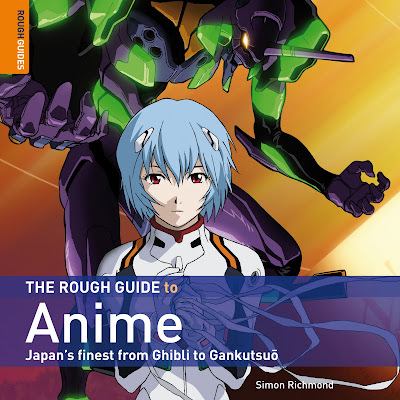My review of the Rough Guides to ANIME and MANGA

Britain’s Rough Guide series has been helping itinerant travelers navigate foreign destinations for nearly 30 years. As globetrotting becomes more casual, and print guides feel more extraneous with the internet’s immediate and wider scope, the presence of the Rough Guides and their counterpart, Lonely Planet, provides security amid the angst of 21st-century travel. We still like to carry paper in our bags—and the Rough Guides’ latest introductions to anime and manga are easy-to-read and suitably compact.
I have been asked too many times the same question about Japanese pop culture: “Where should I start?”
These books are your answer.
The Rough Guide toAnime takes you deep into the art form’s best stuff—without speaking down to you. You’ll learn about the major films, with author Simon Richmond’s easygoing guidance, and broaden your horizons via his questing voice. You will finally realize why Japanese animation “supersedes the American model,” as Richmond writes, without missing the goods. Richmond loves the form, and his prognostications and descriptions more than make upfor his lack of insider knowledge. “Mind Game is a surreal world unlike anything you may have encountered,” he writes about Studio 4 C’s 2004 epic. It’s a tasty tease.
Some might say that Japan is nothing more than a subculture of Western desires, but both books seek to debunk the silliness of subcultural mystique,without denying the fundamentals of attraction.
And so The Rough Guide to Manga serves its purpose—a 200-plus page introduction

to the magic of Japanese comics, penned by aficionado Jason S. Yadao. Yadao helps us understand why manga have become hugely popular in the West without watering down their essentials—good stories, smart drawings, and plenty of naughty suggestive images to keep the audience hooked.
Both books break down the forms into bite-sized categories. You will learn why certain titles have succeeded abroad, why others are local-only, and what makes them so special to begin with. You’ll find out why your kids get it while you don’t, and what you need to understand in order to be on the same page. Or why a little blue cat named Doraemon is huge in Japan, but virtually unknown overseas, and why another feline named Kitty White (a.k.a. Hello Kitty) is mightier worldwide than Mickey Mouse.
In short, Rough Guide’s two books on anime and manga arrive right in time for Christmas—when we all need a little help understanding how global our worlds have become. If you’re intrigued by Japanese pop culture but are not sure where to begin, these works serve as helpful catalogs. If you’ve never heard of these stories and want to know more, they are the books to get you started.

.jpg)